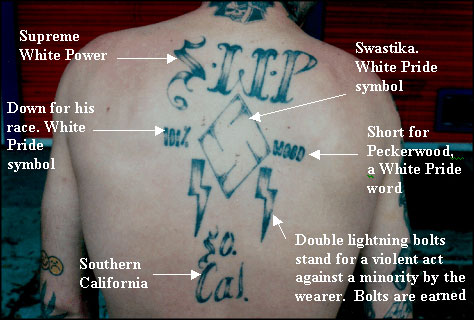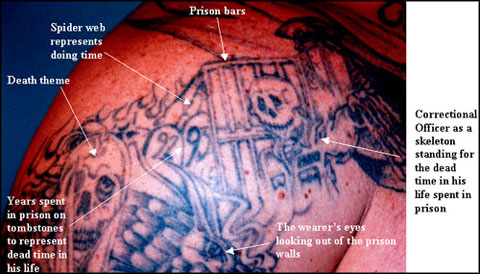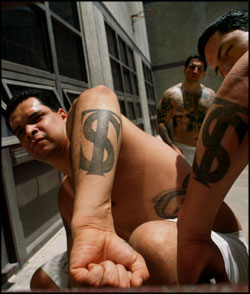Gang Culture: Introduction
I decided to explore the Culture and its different cultural impact on the formation of different ethnic gangs evolving from a modern urban street gang of Texas because I think this study will help me to excel in my performance as a cultural consultant at my workplace. I think a cultural consultant of a multinational company like ours should possess an in-depth knowledge of the culture in which he or she works. Moreover, I had been a project manager in that state for almost two years.
During those two years, I have always been fascinated by the dare-devils of the gang who seemed to me to be the new orientation in the heart of the miscellaneous composition of American culture. Again I have an intention to visit the area for a business purpose in 2010. Besides I have a good number of friends who are from different ethnicities with the help of whom it will be easy for me to obtain the in-details information about the culture.
Though the term “gang culture” is reminiscent of the dare-devils that are considered to be its aftermath, it has a deeper root in the history of America. Primarily gangs based on different ethnicity emerged as ensuring more social security in the conflicting interests of various social groups. Since the adventure of the British-American settlers who were rushing to the west to take hold on the vast land the spirit of the wild west was inherited by their later generations.
Afterward, America’s immigration policy was helpful to welcome a diversity of cultural people to the American land. But the feeling of alienation evolved from the miscellany of cultures forces them to be united under groups who hold the same beliefs, share the same language and customs, and establish their own rules and codes of conduct. These gangs continue to exist bypassing their customs “to new members by rites of passage from generation to generation.” According to Carlie (2002),
“Gang members identify themselves as a people that is separate from the rest of society.”
When the phrase, ‘Fuck you. You get in my way, you’re dead’ that is typical of the environment of a gang; it is not difficult to understand the threat to the nation, that is posed by this type of emerging culture. According to Carlie (2002),
“A police gang unit commander said, The culture of the prison is now the culture on the street……… And they don’t even think twice about it before they kill someone, or think about it again after they’ve done it.”
Gangs are mini-societies within a larger society. A gang nourishes a culture of its own. In most the culture of a gang is maintained and taught by its members. The teachings of members of a gang generally include the matters: how to dress, how to behave with women – or men i.e., usually the gang of a culture is rooted in its ethnic customs, behavior, and religion. “The culture of a gang is imparted from one generation to the next through a process called socialization” (Carlie, 2002),
Gang culture in Texas
There are several gangs in Texas consisting of different racial people. Mainly these gangs are comprised of Hispanics, African-Americans, American-Indians, native Indians, Mexican-Americans, and Caucasians, etc.
They are:
- Texas Syndicate
- Raza Unida
- Hermandad de Pistoleros Latinos
- Mexikanemi
- Barrio Azteca
Sociological features of Gangs in Texas
Gangs of Texas like other gangs have their particular territory and they show a common culture. They have some practices that differentiate them from each other to be recognized as different gangs. Their members are to maintain the practices. The recognition key that the members have to possess virtually or materially, helps them to identify an aggregate of people as a group. These gangs of Texas can easily be viewed as a mini-society or subculture as they put stress on their territorial boundaries. The boundaries are very often defined as a street corner, city park, market range identified in terms of the drug sale. At any cost, they maintain the sacredness of their territory. According to an article by Gardner (1992),
“Gangs defend their territories to protect their narcotic business,”… “Each street corner, dope house, salesperson, distributor, or customer is part of the territory.”
Like the behavioral expectations of any society, gangs maintain their own-made or their ethnic cultural norms. Violations of the norms result in punishment of the person who disrespects the norms of a gang. Violation of the norms of a gang may lead to bloodshed between the gangs. Dissing by a person, a slang that is used to refer to the disrespecting of norms of a gang is a degradation for the whole gang.
If the gang stands for a person’s whole sense of self, then everything he has, wears, or says is colored by gang identity. Thus, from the gang member’s distorted viewpoint, any insult to even the trappings of gang identity is ground for battle.” (Gardner, 1992, p. 54)
Norms and Values
The people of a gang usually share the same language, same group beliefs, norms, values, emblems, symbols, and artifacts. They commonly have an argot that they developed. Emblems, symbols, signs, and Graffiti are forms of argot they use to communicate within themselves and between gangs. When communicating they use a range of vocabulary that represent their identity as members of the different gangs. Also, they have different ways of communicating and expressions. Again there are some popular terms used in the Hispanic groups. ‘Numbered beating’ and ‘red pee’ is the term that refers to the torture of hitting the victim on the same place of his body or his kidney so that blood is emanated through his urine.
For example, if they want to kill a member of another gang or as a non-gang person, his crossed-out name or photo will be painted on a wall or something visible to the public. Again the gang members use number bearing special significance (such as187 that is used in the California state penal code number for murder) as a symbol of their various delinquencies.
One of the norms that are maintained among the Hispanic gangs of Texas is not to cooperate with the police. Several others are not to leave an insult unaddressed and not to violate the dress-up code of the gang. If a member is found to violate any of these norms, the violator member would receive from the gang a ‘time violation’ that includes physical torture for few minutes.
Art and Music Used by the Gang
Music has a considerable place in the gang cultures of Texas. The type they use is gangster rap music. Music is used to glorify the gang and it specially relates to the gang values and norms. The conflicting interests with the society and other gangs are composed with the theme of the music. Through the music, the gangster rappers glorify violence against society, racism, and the derogation of women.
“And it exhibits and supports a disregard for the value of life. …. According to a police officer, as he was frustrated with one of the gangster rapper, Gangster rap not only glorifies being a gangster, Ice T is living proof that gangsters are glorified and can even become popular recording artists. 2 Pac, of course, would be another example of this, but gang banging resulted in his premature death” (Carlie, 2002).

The symbols that they use to express the individuality of their gangs often turn to be their admiration for art. Tattoo culture is considered to be a part of their identity. Gangs have their artifacts such as graffiti, individual dress up, special jackets, special types of guns and cars.

Source: (Morales, n.d.).
Source: (Morales, n.d.).
Role Expectations from the members in a Gang
The tendency that prevails in a gang is helpful to grow an organizational zest in its members. The various tasks helpful to sustain the gang are distributed among the members respective to their expertise. Also, there is a competitive environment for the members. The status of the members is classified into the roles of a leader, a lookout, a dealer, an informer, etc. Each member is strictly obliged to fulfill their task.
The statuses may vary according to the influential power of the members. However, a member assigned with a role is to perform a set of certain tasks. For example, the O.G usually performs the role of an advisor, along with his role to keep harmony within the gang members. He is also to protect them. He also has to maintain the qualitative excellence of the members to commit a crime and do whatever he wants.
In an interview, Charles, who is a city gang member, defines his role and the role of others in the other gangs of the city. He describes different roles in a gang. His description is as follows.
The Role of a LookOut
The person who generally performs the role of keeping an eye on the police and security when the others members of the gang remain involved in selling drugs is called a lookout. Several lookouts are set around a drug spot. They are to maintain the members’ safety from the security forces. The lookouts also focus on the fact that any rival gang member should not frustrate their drug customers.
The role of a Flunky
The role of a flunky is to obey what is told to do by a member of upper status. He generally has no choice of his own. In Charles’ words as he said, “Go kill so and so, go get this, get rid of that… stuff like that …. the flunkies are of limited power. They work as a passive killer machine of the gang. Charles says “no feelings. Or, if they do, they hold ’em in. They’re cold-hearted. They don’t care about anything” (Carlie, 2002).
The Role of a Shot-Caller
The role of a shot-caller is that of a semi-leader. He is to lead the gang daringly and tactfully where it is necessary to fight for the gang. He tackles any on-coming danger for the gang. He is considered to be self-dedicated by the gang. He may be a regional leader or a leader of a particular territory. According to a gang member, as he spoke of the gang life,
“Gang members sometimes switch gangs… they’re Bloods one week and Crips the next. Or you’ll find a guy in red next to a guy in blue, both selling drugs next to one another. Today it’s all about money. They’re not for real [not dedicated to the gang, otherwise they would not work together like that]. Some guys take the gang thing as a game, just a phase in their life. For others, it is their life.” (Carlie, 2002)
Ability to Commit Violence as a fact of Approval
The gang culture is destined to beget a conflicting environment with the rival. Clash of interest is the vitality of a gang. Mainly a gang is driven by financial factors. It appears to be uncompromising for the financial term. Very often a gang has to achieve its target by committing a crime. Sometimes it is to achieve dominance over the rival gang that leads them to commit murder, torture, and violence to other gang members.
As a result gang culture is oft-repeatedly characterized as a culture of violence. The culture includes the culture of physical assault. At the grass-root level the use of knives, mini-gun, batons, and other small sharp weapons is very frequent. According to Carlie (2002), “[i]t is a culture of physical assaults, guns, knives, bats, and anything that one can use to protect him- or herself or gain an advantage over another person or situation.”
The Rise of the Gang: Why
Indeed frustration is the root cause behind the rise of these gangs in Texas. Also, there are several other factors. The rushing youth are manipulated by the major international mafia gangs to preserve their business interests. Unemployment problems, lack of proper education, the gorgeous exhibition of the gang members on cinema and film easily allure the daring youth. Family crisis, incompetent parents, social discrimination can also result in involvement in the gangs.
Most of the young gang members join the gang during their imprisonment. “Among the 600,000 inmates being released from prison annually into American society are those who were gang members before their incarceration and those who joined a gang for the first time while in prison” (Carlie, 2002). Generally, the youth gangs excel in their performance to commit a crime when they are assisted by adult convicts. These ex-convicts put their efforts to give the youth gangs an organizational shape. They create a sense of loyalty among the young gang members. During their imprisonment, the juvenile criminal is trained by the adults to organize to defend the others.
“The prison environment tends to cause an amalgamation of gangs to provide strength in numbers against other and more threatening groups in the prison” (Carlie, 2002).
Charles, a city gang member, says about the culture that exists in the gangs. He commented that ‘gangs in the community are not organized.’ Again he speaks of the rise of the gangs. He said, ‘We got it from L.A. Some L.A. people came here and started it.’
In Details of Texas Syndicate
Texas Syndicate is one of the powerful Texan gangs. The gang usually consists of Mexican-American and Hispanic manpower. Consequently, the racial makeup of the gang is off the Mexican-American/ Hispanic and the gender makeup of the gang is male. In the 70s the Texas Syndicate was established in the Folsom prison in California (Mafia Stars, 1 May 2007).

The Aryan Brotherhood and Mexican Mafia were directly involved in the establishment of the gang. The two gangs who were in need of a Texan gang that will be in their favour helped to organize the Texas Syndicate.

Characteristics of Growth
Texas Syndicate is presently increasing its Membership by recruitment. They recruit members Columbia, Cuba, and Mexico due to its racial origin. “They have made attempts to recruit in the Florida Department of Corrections. [Generally] A TS member is called a ‘Carnal.’ A group of members is called ‘Carnales’.” (Major Prison Gangs, n.d. and Davydov, 17 September 2006). Within the gang ‘Texas Syndicate’ a recruit is named a cardinal. The area leader of the syndicate holds the post of the chairman. The TS uses this type formal rank to refer their members in order to evade the State security force.
The Identifiers or Symbols Used in the Gang ‘Texas Syndicate’
A member of the Texas Syndicate usually wears tattoos with an inhibited “TS” in some places that need a prying eye to find. Very commonly the back of the right forearm, in some cases the calf areas, neck and chest are the place where the tattoos are positioned.

Rivalries and Allies of the Texas Syndicate
The Texas Syndicate has a long cherished rivalry with Aryan Brotherhood, La Nuestra Familia, Mexican Mafia, Mexikanemi, Mandingo Warriors; the gangs who pose a threat to the interest of the ‘TS’ but the gang has been forced to develop associations with the Texas Mafia and Dirty White Boys. Because of the documented act of violence the gang has been enlisted as a Security Threat Group. The Texas Syndicate is usually involved in the trafficking of drug, group violence, series murder, series rape and the violation of state law.
The In-details of Barrio Azteca
Barrio Azteca is another Hispanic gang of Texas. It generally bears the emblems of “BA”, “EPT”, and “Plumed Aztec Warrior. In 1986 The gang was established by five street gang members of Texas. It was established in the Coffield Unit of TDCJ. In order to unite the street gangs of El Paso street gang members the BA was formed. Primarily the gang was able to collect 35 members and so far it is assumed that the gang’s present members are about 1,000. Now the gang has stretched its network over Arizona, California, Colorado, Illinois, New Mexico and Mexico.
The Gang Culture Prevailing in the Barrio Azteca
The strength of Barrio Azteca mainly pivots on the picked-up members of the street gangs. The recruitment system bears a significance that differ it from other gangs of Texas. The BA always focuses on the capacity of the recruits to commit violence for the gang’s interest. The rules that are to be followed by the recruit are destined to find out the ablest. Usually the gang recruits its members from the street gangs: the Varrio Hacienda Heights, Varrio North East, Colonel Street Locos.
These street gangs help the BA to perform their narcotic business. The Barrio Azteca has a warring history with several street gangs and with the Texas Syndicate and Mexikanemi. Presently the gang cherishes rivalry with Aryan Brotherhood of Texas, Raza Unida, Texas Chicano Brotherhood, and Texas Syndicate. The Barrio Azteca maintains their local environment in order to perform illegal activities. According to a research article,
“The Barrio Azteca has a very high propensity for violence, with the BA being responsible for 6 murders in the El Paso County Jail (Texas) within an 18 month period” (Barrio Azteca, n.d.).
The Barrio Azteca is accused of weapons violations and the sale of narcotics. Besides they are involved in physical torture, murder, series rape and theft.
The Gang Culture of Mexikanemi
The racial makeup of Mexikanemi is Mexican-American and Hispanic. The gang has certain as their symbols. The colours are Green, Red and White. The group bears several emblems such as Initials “EME” Mexican Eagle (Feathered war shield over crossed machetes), “AZTLAN”, “MEXIKANEMI”, Initials ‘MM’ or ‘M.’ The gang has rivalries with the Texas Syndicate, Raza Unida, New Mexican Mafia ( Arizona ), Black Guerrilla Family, La Nuestra Familia. The allies of the gang are: Aryan Brotherhood of Texas ( ABT ), Mexican Mafia ( EME ), Hernanidad de Pistoleros Latinos ( HPL ), Latin Kings, of which some are international mafia gangs. (Carlie, 2001-2002)
The Ways of Recruitment within the Gang
Members are generally recruited from the Mexican-American/Hispanic inmates. Women and girls hold a good position in the Mexikanemi because they can be manipulated more easily than the male. The EME is commonly considered to be a “blood in, blood out” gang.
“The wives, girlfriends, and relatives of the EME are held in extremely high regard due to their support of drug transactions, financial activities, and mail-forwarding operations” (Major Prison Gangs, n.d.).
Criminal Activities of the Mexikanemi are as usual. They are involved with Sales of narcotics for their financial backup. Besides they are accused of murder, escape, extortion, weapons violations and assault, gang related violence. Killing has a special respect as a norm in the Mexikanemi. Killing is considered to be a means of discipline or gaining respect among the gang.
“EME killings are extremely gruesome and calculated to establish fear and intimidation” (Major Prison Gangs, n.d.).
The EME has a deep root in history. In 1960s it was established in the Devel Vocational Institute in Tracy. It was the institute of the California Prison System. The gang was initially named the California gang. Gradually it changed into a criminal gang that was involved in the trafficking of narcotics, extortion, and murder. Around 1970s the prison authority became aware of the criminal presence of the organization and attempted to disperse the gang members. Afterward being backed by the Mexican Mafia the gang took the control of the prison.
The Nuestra Familia gang and the Texas Syndicate formed an alliance to defend the Mexican Mafia (EME), the Aryan Brotherhood, and Black prison gangs “that existed in the California penal system. Members of the Texas Syndicate migrated back to Texas from California and were eventually arrested and re-incarcerated in the Texas Department of Correction.” Mexikanemi Information.(n.d.). In 1984 the present EME of Texas was built in the Texas Prison System. Their sole target was to protect ‘the Hispanic inmates of the Texas Prison System from the Texas Syndicate.’
References
American Justice. Web.
Barrio Azteca, (n.d.). Web.
Carlie, J. Mike, (2001-2002). Mexican Mafia. Into The Abyss: A Personal Journey into the World of Street Gangs. Web.
Carlie, K. Michael. (2002). Into The Abyss:A Personal Journey into the World of Street Gangs. Web.
Davydov, Dmitry. (2006). US Prison Gangs – The Texas Syndicate. Crime And Criminals. Crime And Criminals Blog. Web.
Gardner, S., Street Gangs in America, Franklin Watts, New York, NY. Cited in Carlie, K. Michael. (2002). Into The Abyss:A Personal Journey into the World of Street Gangs. Web.
Mafia Stars (2007). Mexican mafia. Web.
Major Prison Gangs. (n.d.). Gang and Security Threat Group Awareness. Web.
Mexikanemi Information.(n.d.). Web.
Morales, Gabe. (n.d.). Texas Syndicate. Web.
Tattoo History, (n.d.). Prison Tattoos. Web.